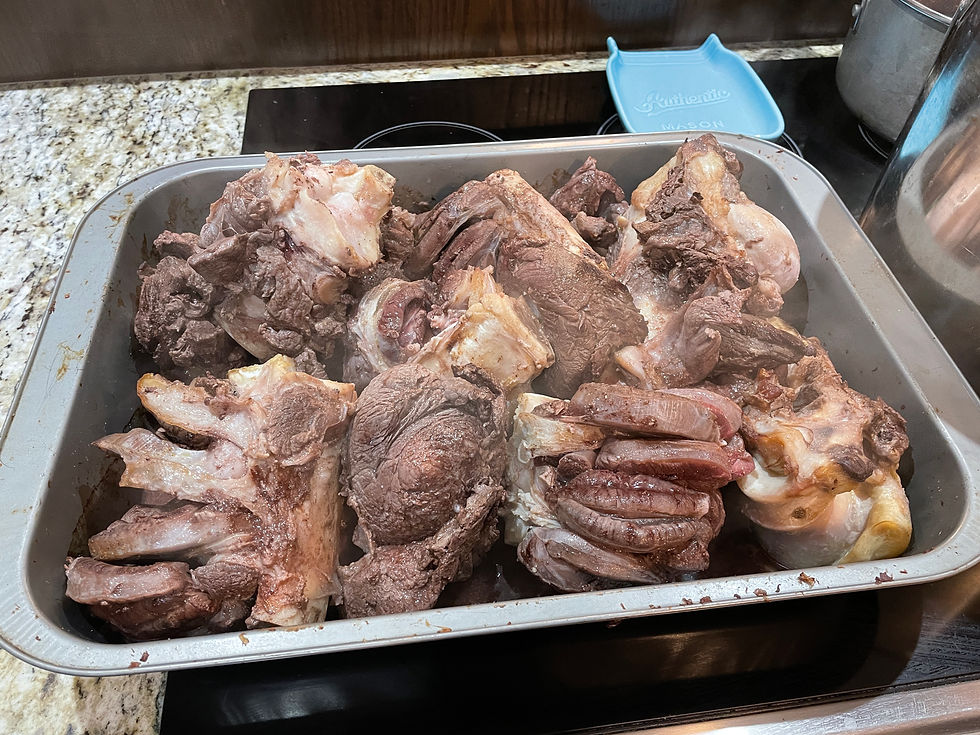Recipe: Venison or Elk Bone Broth
- Sarah Honadel
- Aug 30, 2023
- 3 min read
Venison or elk bone broth or stock is a simple way to use even more of your big game harvest this fall. It's relatively simple to make, although it is time-consuming, and has tons of health benefits.

Health Benefits of Bone Broth
Boosts collagen
Supports healthy digestion
Helps maintain the immune system
Improves joint pain and stiffness
Supports healthy sleep
How to Use Bone Broth
Drink it warm
Boil potatoes or pasta in it for added flavor
Make soup or stew
Make sauce or gravy
How to Make Bone Broth
Ingredients:
4 lbs deer or elk shanks with some meat still on them
Olive oil
1 onion, chopped
2-4 large carrots, chopped
2-4 celery sticks, chopped
2 tbsp rosemary, fresh or dried
1 tbsp ground black peppercorns
1 tbsp sea salt
1 tbsp dried thyme
1 tbsp dried sage
2-4 bay leaves
Directions:
Cut the bones into smaller pieces to fit into a roasting pan.
Tip: You can use a bone saw or a saw zall for this.
Coat the bones with olive oil, place into a large roasting pan, and cover—roast at 350°F until browned. Roasting the bones first gives the bone broth the best flavor.
Remove bones from the roasting pan and place into a large stock pot.
Tip: You can use a crock pot, but this would have been multiple batches in my 6-quart crock pot, so I chose to cook it on the stovetop. You can also make smaller batches by using fewer bones.
Add the chopped onions, carrots, celery, and spices to the pot with the bones. Fill with cold water until everything is covered.
Bring to a boil over medium-high heat, then skim the frothy foam that forms on the surface.
Lower the temperature and let the broth simmer for 4-6 hours on low heat. You'll want it to steam but not fully boil. The goal is a slow cook to release all of the flavors.
Using tongs, remove all of the large bones from the pot.
Set a fine mesh strainer (I use a honey strainer) over another large pot and ladle the broth into the strainer. Tip: Do not pour the last bit of broth through the strainer, as it will have sediment that will be fine enough to pass through the strainer.
Discard the remaining broth, the bones, and all vegetables in the strainer.
You can now freeze or pressure can the broth.
To freeze, let the broth cool and ladle it into quart jars or quart freezer bags, leaving about 2 inches of space for expansion, then freeze.
For pressure canning, prepare a weighted gauge pressure canner and heat quart-size jars in simmering water. Ladle hot broth into jars, leaving 1-inch headspace. Wipe the rim, center the hot flat lid on the jar, then apply the band until finger tight.
Process the stock in the pressure canner at 10 pounds of pressure for 25 minutes (20 minutes if using pint jars); adjust for altitude if required.
Once processing is complete, let the pressure canner naturally return to zero pressure and wait 5 minutes, then remove the lid. Remove the jars and place them on a towel on the counter. Check the seals after 24 hours. If a jar does not seal, use it with the week or freeze the broth.



Sarah Honadel is an avid outdoorswoman from Kentucky, now living in Idaho, who enjoys hunting big game and waterfowl and saltwater fishing. She is a team member at Huntress View, Pro Staff for Browning Trail Cameras, and Pro Staff with Ridge Patrol Clothing. Follow her on Instagram @sarah.honadel.outdoors and @arrowridgecreations.


BAYAR4D link alternatif login dan daftar agen slot online resmi dan percaya
BAYAR4D
BAYAR4D
BAYAR4D
BAYAR4D
BAYAR4D
BAYAR4D
BAYAR4D
BAYAR4D
BAYAR4D
Great article! The recipe for venison or elk bone broth provides a delicious and nutritious way to use bones from game meat. It highlights the process of extracting flavors and nutrients, making it perfect for those looking for a hearty, homemade broth. For reliable tools to help with your cooking or other projects, Check out Industrial Cart for durable, high-quality products. Visit us at Industrial Cart for all your tool needs!
BANDAR 4D KASKUSTOTO KASKUSTOTO KASKUSTOTO KASKUSTOTO SLOT DEMO GRATIS really love this article so bad
KASKUSTOTO KASKUSTOTO KASKUSTOTO KASKUSTOTO TOTO MACAU TOTO TOGEL TOTO TOGEL KASKUSTOTO SLOT THAILAND love from us to this article
Descubre la emoción de los juegos de casino gratis Chile, donde puedes disfrutar de tragamonedas, póker y ruleta sin costo alguno. Ideal para practicar estrategias o simplemente pasar un buen rato sin arriesgar dinero.